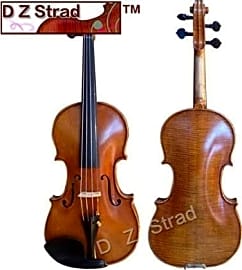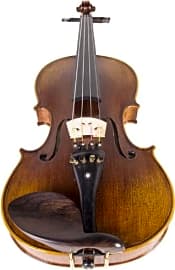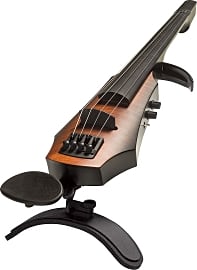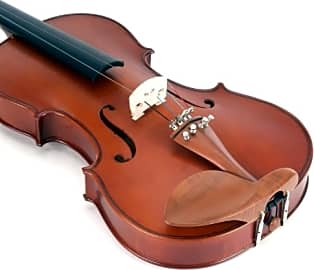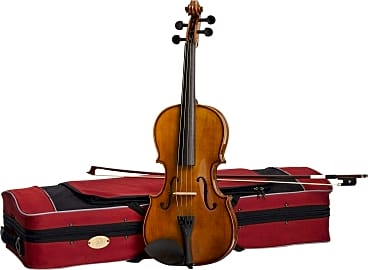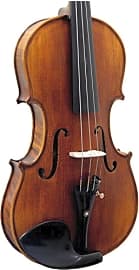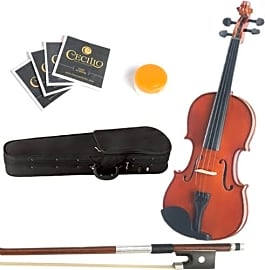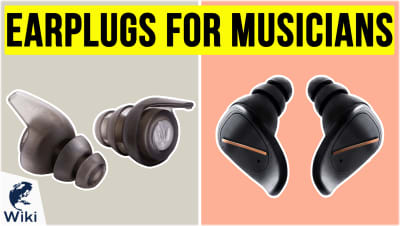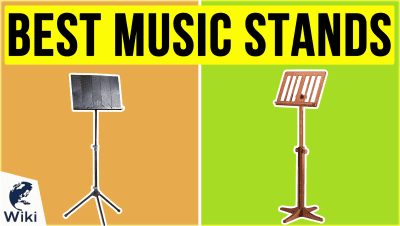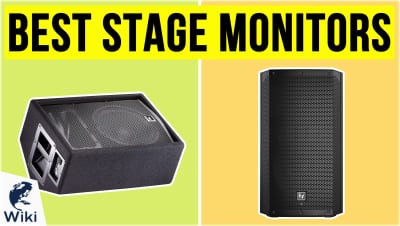The 10 Best Violas

This wiki has been updated 35 times since it was first published in October of 2016. The enchanting viola is slightly larger and lower in tone than its relative, the violin. We've included models ranging from reasonably priced entry-level instruments, to suit those interested in taking up the instrument, to more expensive, handcrafted options for those who are already accomplished musicians, plus a mixture of acoustic and electric violas to suit a range of styles. When users buy our independently chosen editorial selections, we may earn commissions to help fund the Wiki.
Editor's Notes
October 12, 2020:
We have made two replacements and one addition to our list in this latest revision. First was our switching of the Cecilio CVA-500 for the Cecilio CVA-600, as we felt that our list could benefit from this mid-range item that appeals to more musically-proficient students and intermediate musicians alike. This model has a number of improvements upon the previous version, including a flamed maple back and sides, as well as ebony tuners, tailpiece, fingerboard, and chin rest.
Our next replacement was to swap the DZ Strad 101 for the DZ Strad model 400, as the top end of our list deserved another high-end instrument for the professional musician, and this is a fine example. With its Italian spruce top and flamed maple back, ribs, scroll, and neck, it is built using traditional European techniques to a very high standard and this is reflected in its price. It is completed by a Brazilwood and carbon-fiber-reinforced bow.
Finally, we added the Mendini MA250 to our ranking, as it is important that we include a good quality entry-level option at the start of our list, that is also affordable enough for beginner players. While this model will not produce the same quality tone of those instruments higher up the ranking, a properly set-up purchase will produce pleasing results at this price point.
March 18, 2019:
Beginner-level instruments are somewhat of a catch-22. It can be hard to justify a huge investment if someone's just starting out, but on the other hand, it can be tough to learn and stay motivated if someone's using poor-quality equipment. This effect is even amplified somewhat on the viola because it's such a difficult instrument for most people to play. And one thing you'll almost certainly hear from teachers or band/orchestra directors is to avoid no-name "viola-shaped objects" that simply masquerade as good instruments, but in reality, are probably not even worth paying the low price for. So it can be difficult to find a budget-oriented, starter instrument — but it is possible. Here we've outlined three brands -- Cecilio, Stentor, and Sky -- that focus on inexpensive equipment and offer some great models at affordable prices. Cecilio's 400 is about as cheap as they get, while their 500 is probably worth it for those on anything but the tightest budget. Stentor is a comparable choice. The Sky is a good one for older people, as it's a little bolder-sounding than the other inexpensive ones, but it's also not available in the more kid-friendly sizes. Moving up the field, D'Luca and DZ offer fantastic choices for the truly dedicated beginner, while Yamaha has one that's ideal for the intermediate player ready to take a step up to the next level. Speaking of Yamaha, their SVV is an all-electric model, and while it's not completely silent without an amp, it's pretty close. This not only makes practicing in close quarters much more convenient, but it can also change the game when you want to eliminate the acoustic sounds for a live performance if, for example, you're running your sounds through a pedal board or a DJ controller. In that same vein, the NS Designs viola we've highlighted here is actually one of the most advanced you'll find on the market; it even uses a specially designed, capacitor-driven circuit that acts as somewhat of a preamp and enables distortion-free connection to nearly any amp you can find. All in all, there's a good range of stringed instruments available here to satisfy all but the most particular professionals.
Special Honors
Lichty Custom-Made Violas Luthier Jay Lichty has been making stringed instruments in the Blue Mountains for decades and his products are known for their warm, clear tones and responsive action. Each custom-built viola is unique and can be made to order in both classic and contemporary designs, with each having its own characteristics and style. Contact Jay via his website to discuss ideas and pricing. lichtyguitars.com
Strings Stick Together
Spruce also offers the durability necessary to support the attention needed by the strings when they're constantly being adjusted.
Learning to play a musical instrument is a beneficial and rewarding experience, from both psychological and creative perspectives. Regardless of the instrument chosen, building skill takes time, dedication, discipline, and desire on behalf of the player. For some, the violin is their go-to choice due to its acoustic range, emotional appeal, and rich history. For others, the elegance of the cello is their inspiration. One of the greatest advantages to music as an art form is the range of choice it offers to those who wish to partake in its magic, but who may prefer to try something special within a family of similar instruments. In such a circumstance, the viola is a great option to consider.
The viola is a bowed and four-stringed musical instrument tuned in perfect fifths at the C, G, A, and D notes. Its C is normally played a full octave below middle C and its tuning is precisely one-fifth below that of the violin, while being a full octave above the cello. The viola ranges in length between 15 and 18 inches, with the most common size being around 16.5 inches. It is larger than the violin and smaller than a cello, making it the "middle child" among this trio, but with a tone that's significantly deeper, lower, and richer than its other two siblings. But how does the viola support an orchestra? If we imagine the vocal equivalents of these three instruments, the violin would represent the soprano voice, making the cello the tenor and placing the viola at the alto range. Similar to altos in a choir setting, the viola carries the responsibility of filling in the harmonies for an orchestra, acting as an accompaniment. Its dark and rich timbre blends the string sections together, while giving body to the orchestra as a whole. I liken the relationship between the violin, viola, and cello to that of a peanut butter and jelly sandwich, with the viola representing the peanut butter and jelly and the two hearty slices of bread represented by the violin and cello. But please don't eat a messy peanut butter and jelly sandwich while playing the viola (or any instrument for that matter).
A viola's anatomy consists of several parts, including a scroll, peg box and tuning pegs, neck, a fingerboard, bass bar, strings, a bridge, sound post, F-holes, fine tuners, top and back, purfling, a tailpiece, saddle, tail gut, end button, and finally a chin rest. Many of these components play an important role in assuring the instrument's overall acoustic performance. The viola's pegs and strings usually get the majority of a player's attention (along with the bow), as each peg is used to adjust the tension of one of the instrument's four strings wrapped around it. Tightening the tension of a string results in a higher pitch, whereas loosening the tension lowers the pitch.
A variety of woods may be used in the instrument's construction, the most common of which are ebony, maple, and spruce. Naturally-aged and straight-grained spruce is ideal for use at the top of the instrument near the scroll, as this is the main location from which much of the viola's sound will resonate. Spruce also offers the durability necessary to support the attention needed by the strings when they're constantly being adjusted. Maple is used to enhance the viola's structural integrity, particularly along its neck and sides. Ebony is leveraged for the pegs, tailpiece, and fingerboard to prevent the instrument from feeling too top heavy. Exotic woods, such as rosewood and boxwood, may also be used for the pegs, chin rest, and tailpiece as a means of enhancing the instrument's beauty and sound characteristics.
Maintaining Acoustic Balance
In addition to being a long-term investment, choosing an instrument is also an extremely personal experience. The viola is no exception, given that its sound must resonate with both the player and the audience to evoke emotion. In order to make this happen, both an instrument's acoustics and construction materials should be among your primary considerations. You must be aware that a viola's sound is relatively mellow and rich with a darker timbre than either of its stringed siblings.
String length is another important factor to keep in mind. Regardless of who's playing the instrument, there should be a coherence in sound quality between all four strings. Short strings are typically more comfortable for a young child to play, whereas long strings will provide greater power and tone consistency as a person's skill level grows.
Finally, ensuring the right type of bow is an extremely important consideration, as it makes the instrument's rich sound possible. The viola's bow should be strong, flexible, well-balanced, and easy to hold.
A Brief History Of The Viola
While there is no definitive date for the birth of the viola, common belief is that the instrument was developed from the ancient bow and string violin instruments found in early 16th century Italy. Famous luthiers, including Andrea Amati and Antonio Stradivari, were pivotal in establishing the basic proportions of the violin, viola, and cello between the 16th and mid-17th centuries.
The first viola sonatas were developed in 1770 by organist and violist William Flackton. Additional inspiration came from famous classical composers like Franz Joseph Haydn, Wolfgang Amadeus Mozart, and Ludwig van Beethoven, treating the instrument as more than just a "filler" for symphonies.
Both Lionel Tertis and William Primrose helped carry the instrument's popularity into modern times, allowing it to remain an integral part of most major orchestras.


